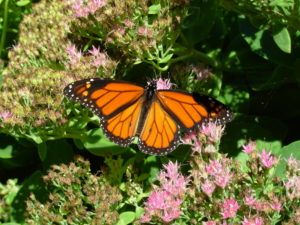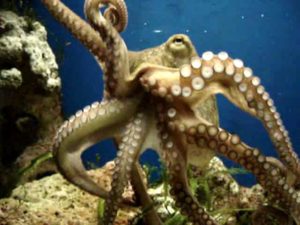What do butterflies and octopuses have in common?
Magic. Magical cells & jumping genes. A natural ability to transform themselves. Personal alchemy!
 Oh, don’t we all know about how caterpillars transform into butterflies? Yet the science behind it cannot obscure the magic of it. The actual cells responsible for the transformation of fuzzy creepy-crawly into winged flutterer are called “imaginal.” Imaginal cells. What a great name!
Oh, don’t we all know about how caterpillars transform into butterflies? Yet the science behind it cannot obscure the magic of it. The actual cells responsible for the transformation of fuzzy creepy-crawly into winged flutterer are called “imaginal.” Imaginal cells. What a great name!
So these little biological units we call cells have genetic orders to morph themselves into whatever is needed to complete the butterfly design. Cast yourself into those inner workings:
“Hey, you! Yeah, you! Hairy cell! Now you’re gonna be a wing cell! Whaddaya mean, how? Look around in your files — somewhere in there are the directions! And be sure to coordinate with the other guys that used to be hair cells. Yeah, alla youse! Flatten out and fly straight, haha! Be sure to get your color specifics! Some of you are black, some might be orange. Have fun with it!”
Magic. Science. Genetic code. These are all words for the same miraculous phenomenon.
And now octopuses! With even neural cells that can rapidly change to whatever the whole organism is needing! Read this excerpt from The Nature Journal:
According to researchers from the University of Chicago, the octopus genome is enriched in transposons, commonly referred to as “jumping genes,” which can rearrange themselves on the genome. Even though their role in octopuses is unclear, researchers found elevated transposon expression in neural tissues. Transposons are known to have the ability to affect the regulation of gene expression and are believed to play major roles in shaping genome structure. (Source)
The headlines for such reports and articles are things like: “Octopuses Have Alien Genes” and such. Because, I guess, nowhere else are these jumping genes found.
Further (emphasis mine):
… the octopus genome turned out to be almost as large as a human’s and to contain a greater number of protein-coding genes — some 33,000, compared with fewer than 25,000 in Homo sapiens.
This excess results mostly from the expansion of a few specific gene families… One of the most remarkable gene groups is the protocadherins, which regulate the development of neurons and the short-range interactions between them. The octopus has 168 of these genes — more than twice as many as mammals. This resonates with the creature’s unusually large brain and the organ’s even-stranger anatomy. Of the octopus’s half a billion neurons — six times the number in a mouse — two-thirds spill out from its head through its arms, without the involvement of long-range fibres such as those in vertebrate spinal cords. The independent computing power of the arms, which can execute cognitive tasks even when dismembered, have made octopuses an object of study for neurobiologists … and for roboticists who are collaborating on the development of soft, flexible robots. (from www.nature.com)
Okay, a lot of verbiage, but I mean, really! How amazing is that! Is all of this! I don’t think I will ever eat calamari again! (These genes are found in squid and cuttlefish as well).
I’ve always liked butterflies. Now I think I’m falling in love with octopuses (not octopi, I’ve been corrected!)
PS Related reading: The Butterfly Story by Norie Huddle


